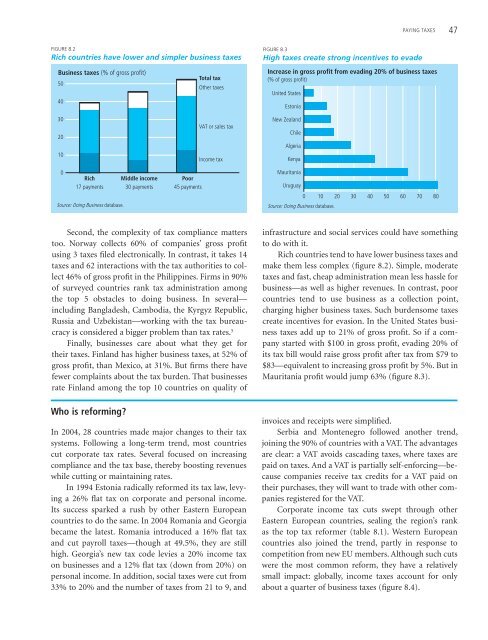Creating
Doing Business in 2006 -- Creating Jobs - Caribbean Elections
Doing Business in 2006 -- Creating Jobs - Caribbean Elections
You also want an ePaper? Increase the reach of your titles
YUMPU automatically turns print PDFs into web optimized ePapers that Google loves.
PAYING TAXES 47<br />
<br />
<br />
<br />
<br />
<br />
<br />
<br />
<br />
<br />
<br />
<br />
<br />
<br />
<br />
<br />
<br />
<br />
<br />
<br />
<br />
<br />
<br />
<br />
<br />
<br />
<br />
<br />
<br />
<br />
<br />
<br />
<br />
<br />
<br />
<br />
Second, the complexity of tax compliance matters<br />
too. Norway collects 60% of companies’ gross profit<br />
using 3 taxes filed electronically. In contrast, it takes 14<br />
taxes and 62 interactions with the tax authorities to collect<br />
46% of gross profit in the Philippines. Firms in 90%<br />
of surveyed countries rank tax administration among<br />
the top 5 obstacles to doing business. In several—<br />
including Bangladesh, Cambodia, the Kyrgyz Republic,<br />
Russia and Uzbekistan—working with the tax bureaucracy<br />
is considered a bigger problem than tax rates. 5<br />
Finally, businesses care about what they get for<br />
their taxes. Finland has higher business taxes, at 52% of<br />
gross profit, than Mexico, at 31%. But firms there have<br />
fewer complaints about the tax burden. That businesses<br />
rate Finland among the top 10 countries on quality of<br />
infrastructure and social services could have something<br />
to do with it.<br />
Rich countries tend to have lower business taxes and<br />
make them less complex (figure 8.2). Simple, moderate<br />
taxes and fast, cheap administration mean less hassle for<br />
business—as well as higher revenues. In contrast, poor<br />
countries tend to use business as a collection point,<br />
charging higher business taxes. Such burdensome taxes<br />
create incentives for evasion. In the United States business<br />
taxes add up to 21% of gross profit. So if a company<br />
started with $100 in gross profit, evading 20% of<br />
its tax bill would raise gross profit after tax from $79 to<br />
$83—equivalent to increasing gross profit by 5%. But in<br />
Mauritania profit would jump 63% (figure 8.3).<br />
Who is reforming?<br />
In 2004, 28 countries made major changes to their tax<br />
systems. Following a long-term trend, most countries<br />
cut corporate tax rates. Several focused on increasing<br />
compliance and the tax base, thereby boosting revenues<br />
while cutting or maintaining rates.<br />
In 1994 Estonia radically reformed its tax law, levying<br />
a 26% flat tax on corporate and personal income.<br />
Its success sparked a rush by other Eastern European<br />
countries to do the same. In 2004 Romania and Georgia<br />
became the latest. Romania introduced a 16% flat tax<br />
and cut payroll taxes—though at 49.5%, they are still<br />
high. Georgia’s new tax code levies a 20% income tax<br />
on businesses and a 12% flat tax (down from 20%) on<br />
personal income. In addition, social taxes were cut from<br />
33% to 20% and the number of taxes from 21 to 9, and<br />
invoices and receipts were simplified.<br />
Serbia and Montenegro followed another trend,<br />
joining the 90% of countries with a VAT. The advantages<br />
are clear: a VAT avoids cascading taxes, where taxes are<br />
paid on taxes. And a VAT is partially self-enforcing—because<br />
companies receive tax credits for a VAT paid on<br />
their purchases, they will want to trade with other companies<br />
registered for the VAT.<br />
Corporate income tax cuts swept through other<br />
Eastern European countries, sealing the region’s rank<br />
as the top tax reformer (table 8.1). Western European<br />
countries also joined the trend, partly in response to<br />
competition from new EU members. Although such cuts<br />
were the most common reform, they have a relatively<br />
small impact: globally, income taxes account for only<br />
about a quarter of business taxes (figure 8.4).

















